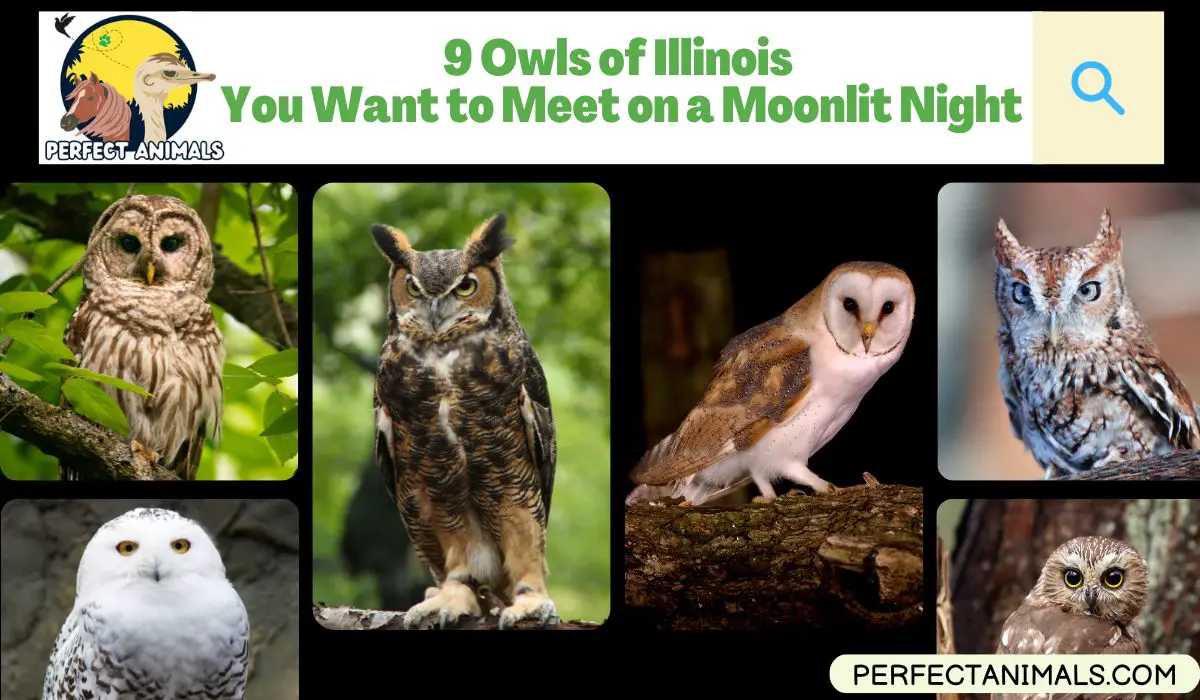With their large, forward-facing eyes and almost supernatural hearing abilities, owls capture our imagination unlike any other bird.
Illinois has eight species of these mysterious raptors, ranging from tiny screech owls to the impressive Great Horned Owl, with its five-foot wingspan.
In this article, we will explore the owls commonly found in the Land of Lincoln, highlighting key identification features, habitats, hunting behaviors, and conservation status for each species.
Whether you’re a birdwatcher hoping to spot these elusive birds or intrigued by all things owl-related, you’ll discover why Illinois is an excellent place to encounter these captivating night creatures.
From dense forests to open prairies, follow along as we unveil the secret lives of Illinois owls.
Owls of Illinois – 9 Types
Great Horned Owl
Among the array of Illinois’s avian residents, the Great Horned Owl stands as a majestic sentinel of the night.
Renowned for its commanding presence and captivating appearance, this owl species exudes an aura of mystique.
With its notable ear tufts atop its large, round head, the Great Horned Owl cuts an imposing figure.
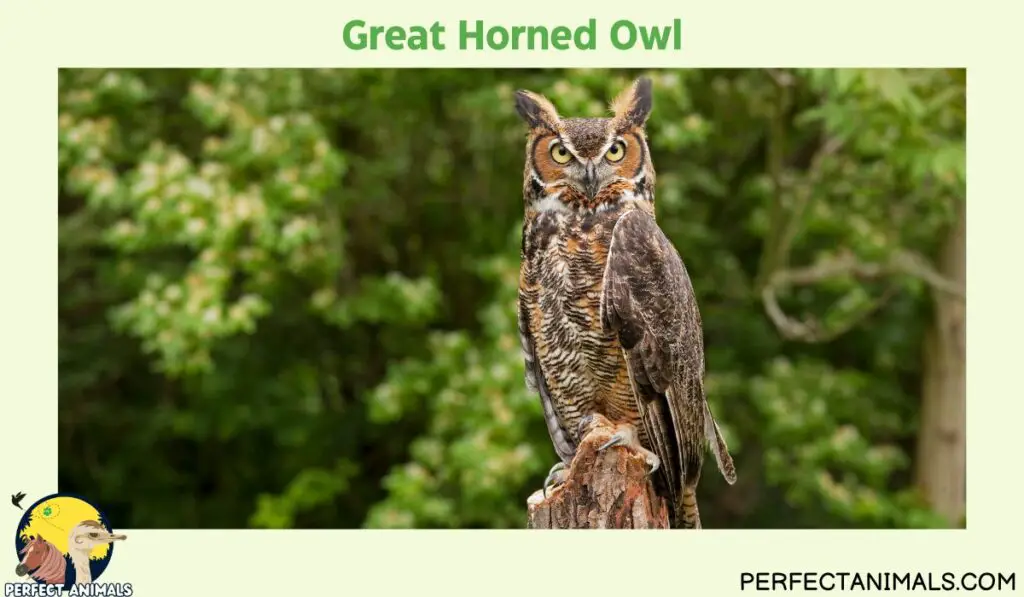
These “horns” are not ears but merely tufts of feathers, adding to the owl’s distinctive silhouette.
This owl’s plumage, a blend of mottled browns, grays, and whites, aids in its camouflage, allowing it to seamlessly blend into its surroundings.
One of its most defining features is its resonant hooting call, which echoes through the woodlands during the night.
The Great Horned Owl is a skilled hunter, preying upon a wide variety of creatures, including small mammals, birds, and even other owls.
This adaptable species can be found in diverse habitats across Illinois, from dense forests to open fields.
Nesting high in trees or even utilizing abandoned nests of other birds, the Great Horned Owl establishes its territory and fiercely guards its domain.
Encountering a Great Horned Owl in the wild is a moment to behold, offering a glimpse into the grace and power of these nocturnal hunters that rule the night skies of Illinois.
Their stoic presence and unique characteristics make them an emblem of the state’s rich wildlife heritage.
Related Article – Why Do Owls Hoot?
Barn Owl
The ethereal beauty of the Barn Owl graces the landscapes of Illinois, particularly favoring the open fields and agricultural areas.
With its heart-shaped, ghostly white face and pale plumage, this owl species captivates observers with its distinctive appearance.
Unlike many other owls, the Barn Owl possesses exceptional hearing, aided by its unique facial disc, enabling it to hunt with precision even in complete darkness.

Its silent flight, a hallmark of owl species, allows it to approach its prey stealthily.
This owl’s diet primarily consists of small mammals like mice and voles, making it a natural form of pest control for farmers.
Nesting in barns, abandoned buildings, or even in tree cavities, the Barn Owl plays a vital role in maintaining the ecological balance in its chosen habitats.
The presence of Barn Owls is not only a testament to their adaptability but also a symbol of coexistence between wildlife and human-made environments.
Their enigmatic nature and contribution to the ecosystem make them an integral part of Illinois’s diverse wildlife tapestry.
Observing a Barn Owl silently gliding over open fields is a glimpse into the mysterious allure of these graceful nocturnal hunters.
Barred Owl
The Barred Owl, with its distinctive “Who cooks for you? Who cooks for you-all?” call, adds its unique cadence to the symphony of sounds in Illinois’s woodlands.
Identified by its mottled brown and white plumage and dark eyes, this owl species exudes an air of tranquility amidst the trees.
Preferring mature forests near water sources, the Barred Owl’s haunting call resonates through the trees during the night, marking its territory and communicating with its mate.
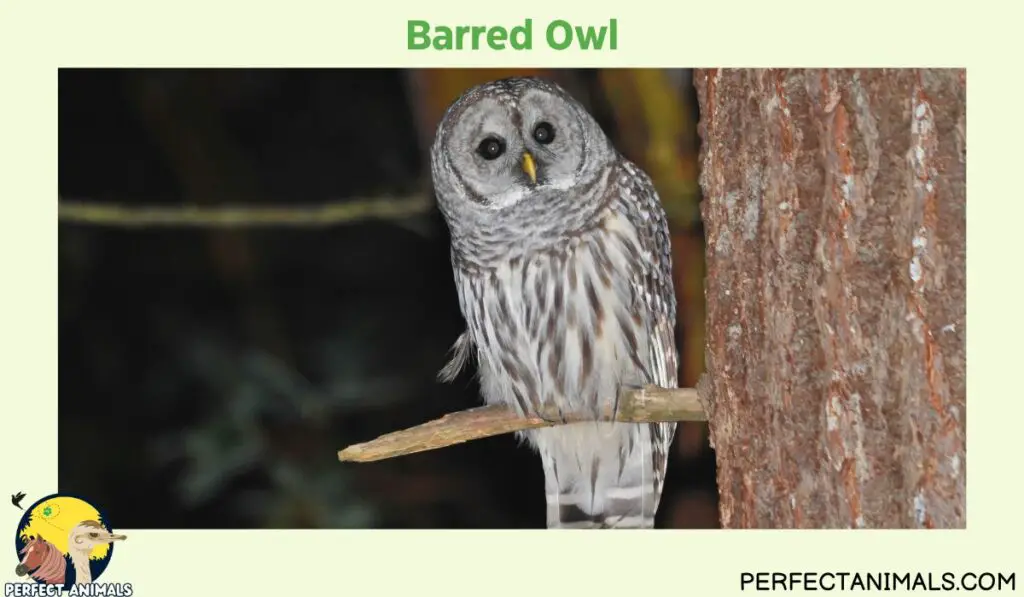
Its adaptability allows it to thrive in various habitats, from dense forests to suburban areas, where it hunts small mammals, birds, and amphibians.
Known for its tolerance of humans, the Barred Owl may occasionally venture into urban areas, perching on branches or exploring wooded backyards.
Its ability to adapt to diverse environments showcases its resilience and resourcefulness.
Encountering a Barred Owl amidst the serene woodlands of Illinois is an invitation to witness the harmony between these birds of prey and their natural habitat.
Their haunting calls and graceful flights serve as reminders of the delicate balance between humanity and the natural world.
You May Also Like – 10 Amazing Birds With Long Legs
Snowy Owl
The Snowy Owl, a majestic creature donning a pristine white plumage with striking black markings, occasionally graces Illinois with its presence during the winter months.
Hailing from the vast Arctic tundra, this owl species stands out distinctly against the backdrop of the state’s landscapes.
Their appearance, reminiscent of a snowdrift, captivates the imagination of birdwatchers fortunate enough to catch a glimpse of these nomads.
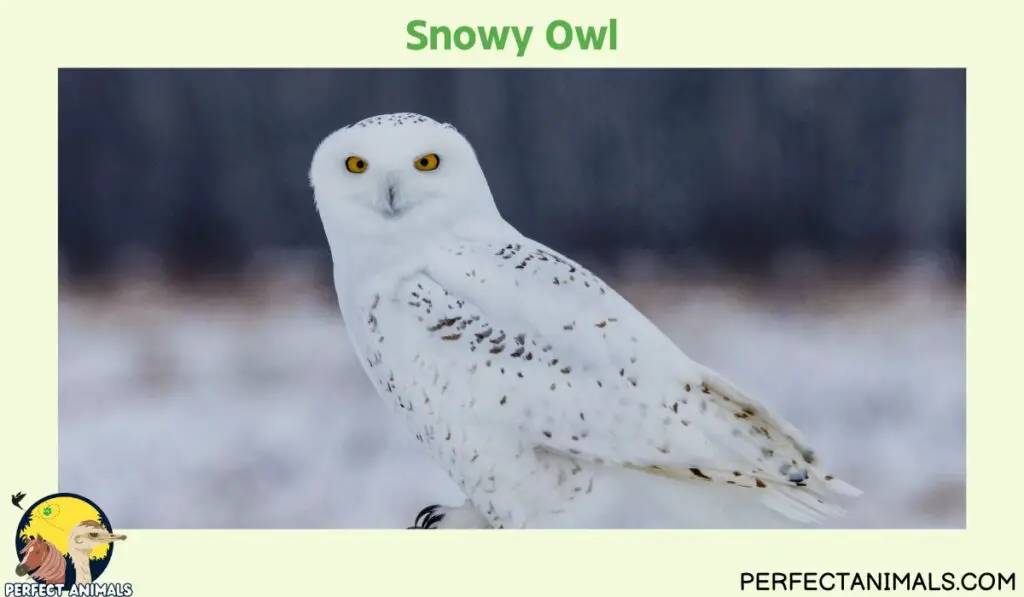
Contrary to many owl species, the Snowy Owl is diurnal, often spotted perched on fence posts, dunes, or open fields during daylight hours.
Adapted to harsh, frigid environments, Snowy Owls primarily prey on small mammals like lemmings and voles.
During irruption years—periods when these owls migrate farther south than usual—Illinois becomes a temporary refuge for these Arctic wanderers seeking food and suitable hunting grounds.
Encountering a Snowy Owl in the midst of an Illinois winter is a rare and magical experience, offering a fleeting connection to the remote Arctic landscapes they call home.
Their transient presence serves as a reminder of the interconnectedness of diverse ecosystems across continents.
Eastern Screech-Owl
The Eastern Screech-Owl, a petite yet charismatic owl species, inhabits various woodland areas throughout Illinois.
With a compact size and either a gray or reddish-brown color variation, these owls possess a remarkable ability to blend seamlessly into their surroundings.
Their piercing yellow eyes, set within a facial disc resembling a horseshoe, give them an enigmatic appearance.
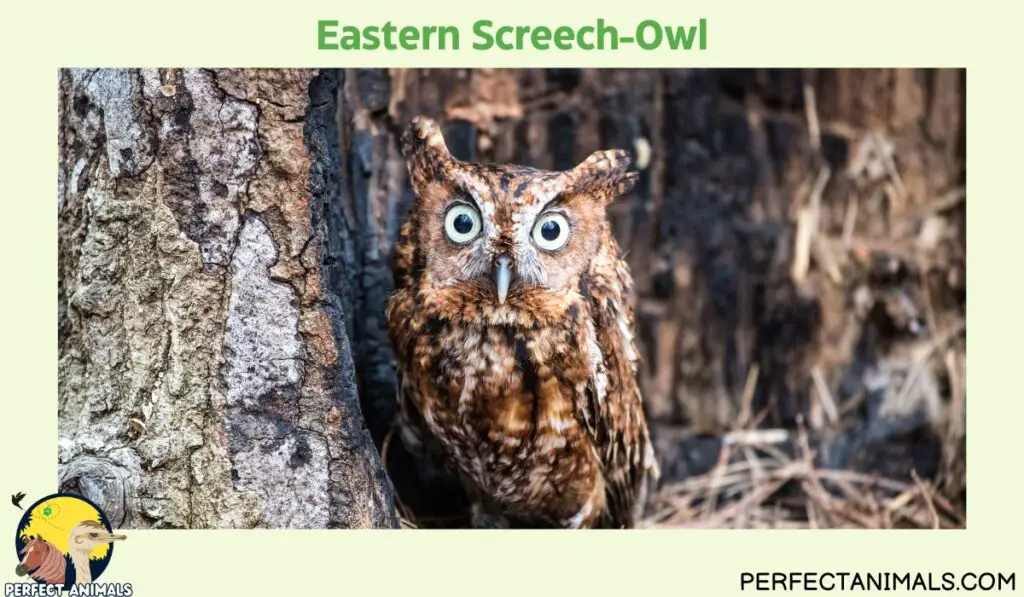
Despite their name, they are more likely to emit soft trills or whinnies than actual screeches.
Eastern Screech-Owls demonstrate versatility in their choice of habitats, from dense forests to suburban parks and even urban areas with suitable nesting sites.
They nest in tree cavities or man-made nest boxes, displaying adaptability to human-altered environments.
Feeding primarily on insects, small mammals, and occasionally small birds, these nocturnal hunters play a crucial role in controlling pest populations.
Their inconspicuous presence and secretive nature add an air of mystery to Illinois’s nocturnal wilderness.
Related Article – Top 10 Birds With Long Beaks
Northern Saw-whet Owl
The Northern Saw-whet Owl, a diminutive species with an endearing appearance, frequents the forests and woodlands of Illinois.
Despite its small stature, this owl captivates observers with its round face, large yellow eyes, and endearing nature.
Named after its distinctive “sawing” call, reminiscent of a saw blade being sharpened, these owls are known for their nocturnal habits and elusive nature.
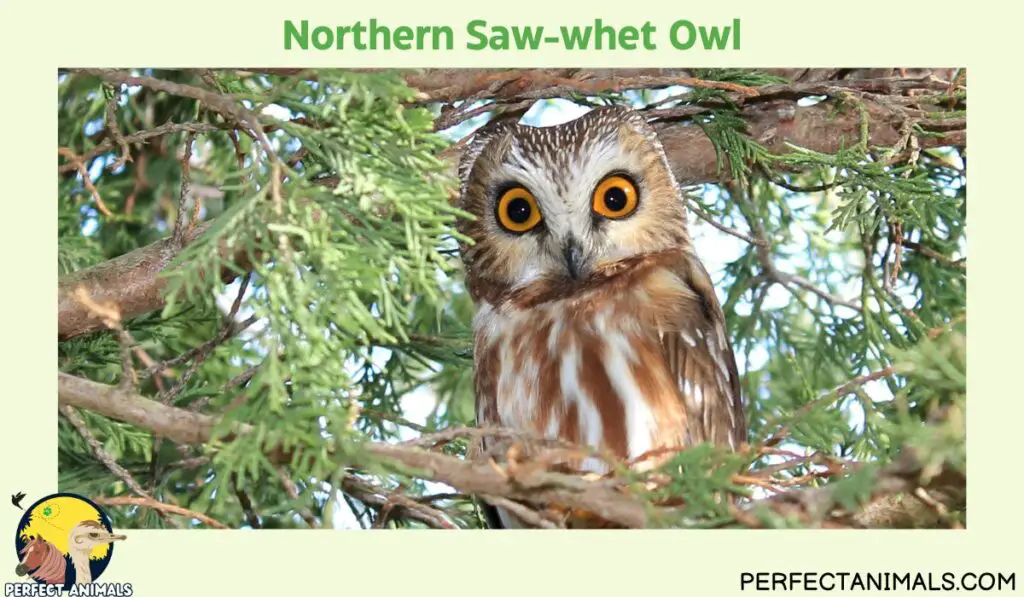
Their high-pitched tooting calls pierce the nighttime silence, often unnoticed by casual passersby.
Northern Saw-whet Owls primarily prey on small rodents like mice and voles, exhibiting exceptional hunting prowess despite their size.
Their preference for dense coniferous forests provides them with ample roosting and nesting sites, often utilizing tree cavities or abandoned woodpecker holes.
Encountering a Northern Saw-whet Owl is a rare and treasured moment for birdwatchers in Illinois, offering a glimpse into the secretive lives of these elusive creatures.
Northern Hawk Owl
The Northern Hawk Owl, an uncommon visitor to Illinois, is a bird of prey renowned for its unique appearance and hunting behavior.
With its long tail, slender body, and piercing yellow eyes, this owl-like species exudes an air of alertness and vigilance.
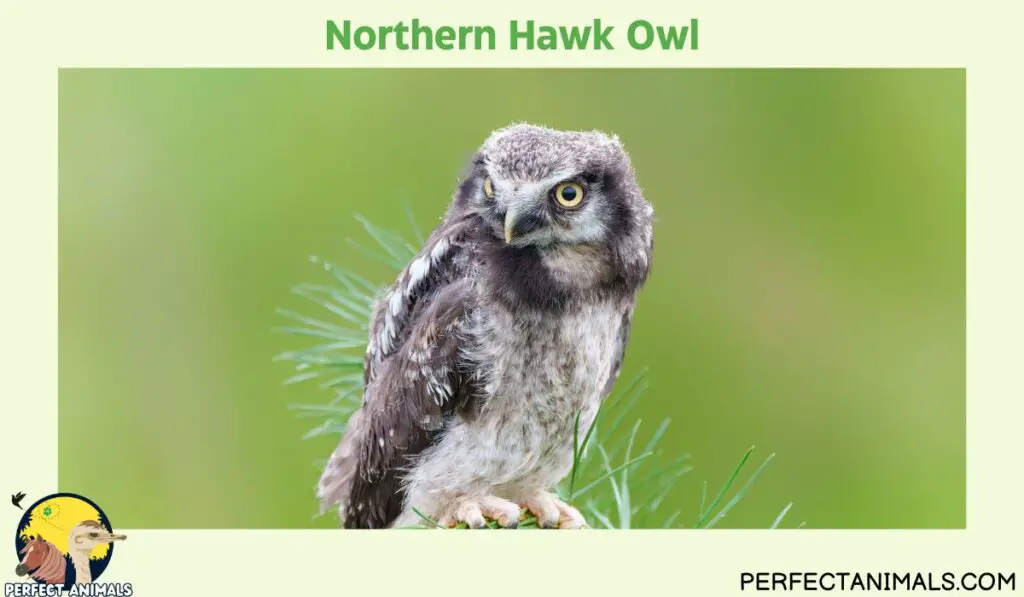
Distinct from typical owls, the Northern Hawk Owl possesses a hawk-like demeanor, often perching atop trees or poles to scan the surroundings for prey.
Its preference for open habitats like fields, meadows, and forest edges sets it apart from other owl species.
Named for its resemblance to hawks in both appearance and hunting techniques, these diurnal hunters prey on small mammals like voles, mice, and sometimes birds.
Their ability to hover briefly while hunting earns them their hawk-like moniker.
Their occasional appearances within the state serve as a reminder of the dynamic nature of bird migration and the ever-changing landscape of avian visitors in diverse habitats.
You May Also Like – 18 Amazing Animals With Long Necks
Long-Eared Owl
The Long-eared Owl, a master of stealth and camouflage, graces the woodlands and forests of Illinois with its secretive presence.
Despite its name, this owl species possesses distinct ear tufts that give it a unique appearance.
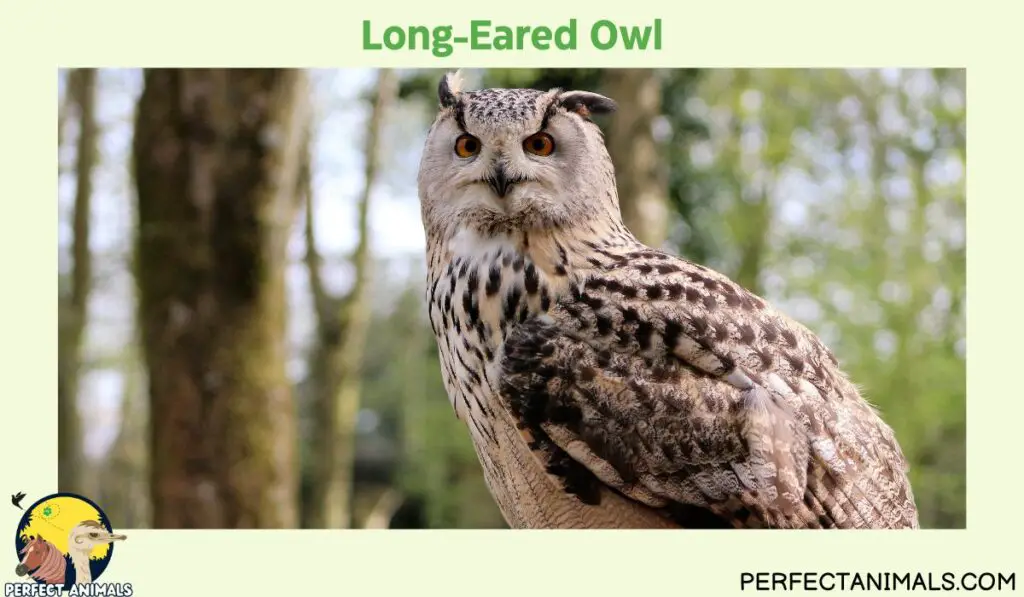
Distinguished by its buffy facial disk and orange eyes, the Long-eared Owl’s cryptic plumage of brown streaks and mottled patterns aids in its ability to blend seamlessly into its wooded surroundings.
Their elusive nature often makes them challenging to spot despite their widespread presence.
Preferring dense woodlands for roosting and nesting, Long-eared Owls often inhabit coniferous or mixed forests, where they utilize thick foliage or tree cavities for shelter.
Their nocturnal lifestyle and silent flight contribute to their reputation as elusive forest phantoms.
Feeding primarily on small mammals like mice, voles, and occasionally small birds, these skilled hunters play a crucial role in maintaining the ecological balance of Illinois’s forest ecosystems.
Their ability to thrive in forested habitats underscores the importance of preserving diverse woodland landscapes for the conservation of these mesmerizing nocturnal hunters.
Short-Eared Owl
The Short-eared Owl, known for its distinctive yellow eyes and diurnal hunting habits, frequents the open fields and grasslands of Illinois.
Recognizable by its mottled brown plumage and short ear tufts, this owl species stands out among its nocturnal counterparts.
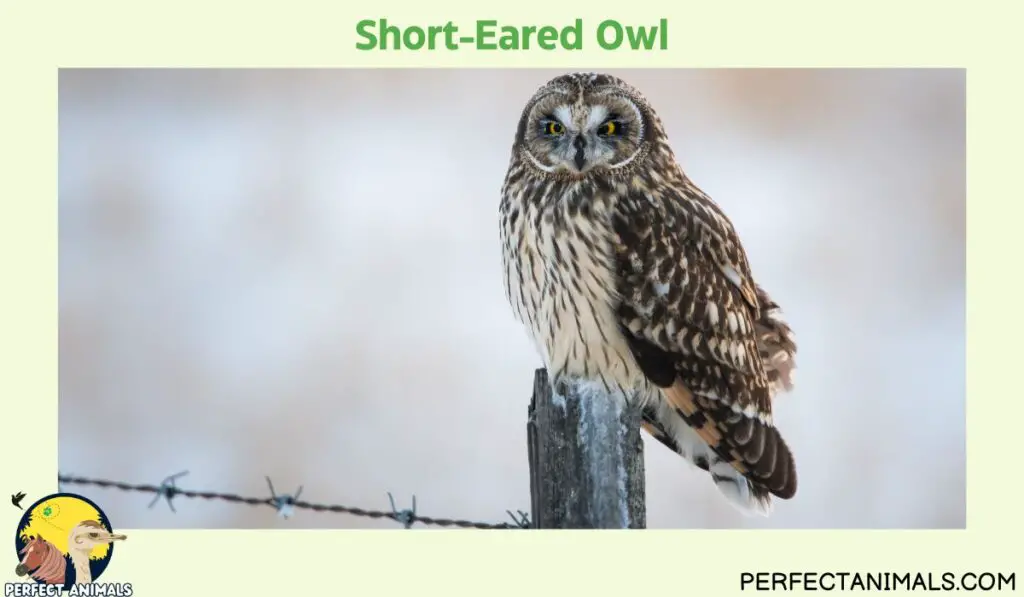
Unlike many other owls, the Short-eared Owl is often active during daylight hours, making it relatively easier to spot as it glides gracefully over expansive open landscapes.
Its buoyant, moth-like flight pattern adds to its unique charm as it hunts for small mammals such as voles, mice, and occasionally small birds.
These adaptable hunters utilize a variety of habitats, including grasslands, marshes, and agricultural fields, where they nest on the ground or in shallow depressions.
Their ability to thrive in diverse environments showcases their resilience and flexibility.
Encountering a Short-eared Owl during a daytime excursion through Illinois’s open countryside is a rewarding experience, offering a glimpse into the captivating world of diurnal raptors.
Related Article – 12 Clever Birds That Eat Spiders
Can You Have a Pet Owl in Illinois?
Owls are wild animals, not domesticated pets. However, it is legal in Illinois to keep an owl as a pet with the proper permits.
The state issues two different types of permits.
Hobby Permit
- This allows you to keep a native Illinois owl species like a Great Horned Owl or Barred Owl as a pet. You’ll need to pass a test demonstrating your knowledge of owl care and pay a $25 permit fee.
Educational Permit
- This permit is for individuals who want to use birds, including owls, for educational purposes. You’ll need to provide a written explanation of your educational program and pay a $25 permit fee.
Even with the proper permit, owning an owl comes with many challenges. Owls require specialized diets, large enclosures, and veterinarians with raptor expertise. And it is illegal to take an owl from the wild to keep as a pet in Illinois.
The best way to enjoy owl encounters in Illinois is to observe these majestic birds in their natural habitats.
But if your passion is educating others about raptors, reaching out to a licensed wildlife rehabilitator about their educational birds may satisfy your owl curiosity.
Final Thoughts
As we have seen, Illinois plays host to an impressive array of owl species, ranging from the tiny Northern Saw-whet to the impressive Great Horned Owl.
Each species fills an important ecological role, helping control pest populations while also serving as an indicator of habitat health.
While elusive, catching sight of one of these mysterious birds perched or in flight is a magical experience for any nature enthusiast.
Their spectral faces and stealth-hunting abilities never cease to fascinate.
Interest in owls also presents opportunities for education and conservation of vulnerable species like the Barn Owl.
We encourage readers captivated by Illinois’ owls to learn more about these species as well as local rehabilitation efforts.
Getting involved with citizen science projects that gather data on owls also helps researchers better understand and protect vulnerable populations.
As essential, wild members of Illinois’ ecosystems, owls deserve both our utmost respect and admiration.
If you are lucky enough to hear their haunting calls or witness them hunt under the cloak of night, consider it a rare privilege.
Our lives are enriched by sharing spaces with these feathered phantoms of the darkness.
Resources – (for further reading)
American Bird Conservancy – Types of Owls: All Owl Species in the United States
The Owl Pages – Owls of North America
Britannica – Owl | Types, Species, & Facts
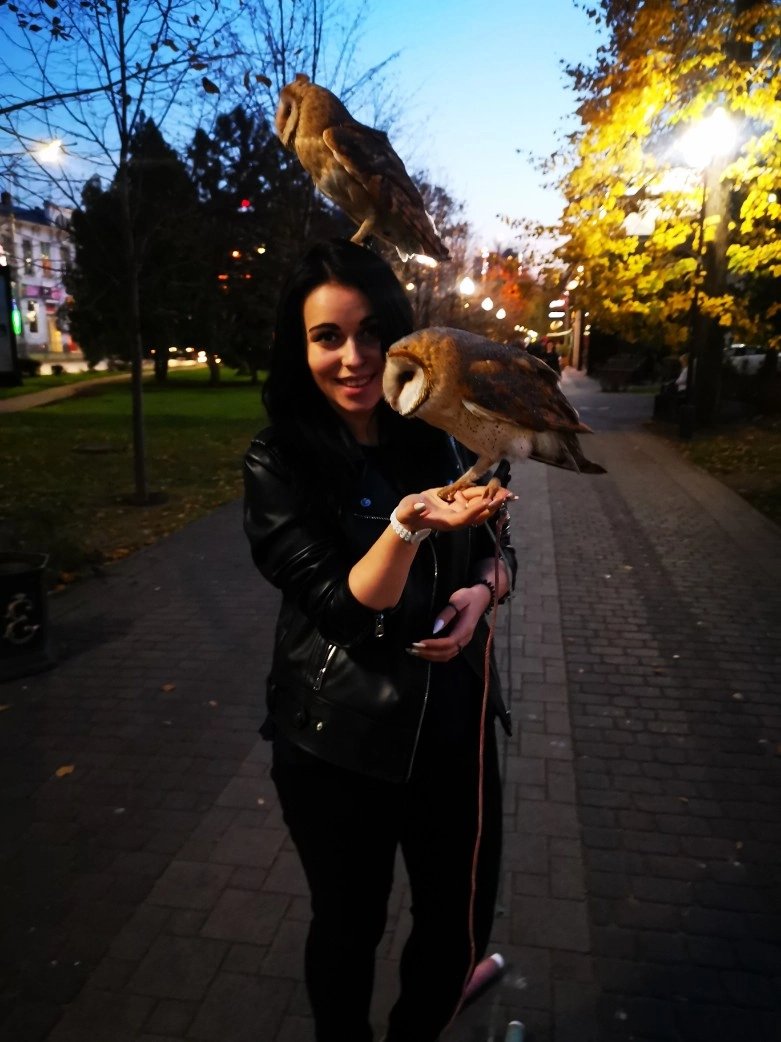
Larissa Adler, an Ornithology graduate from Charles Sturt University, is an avid birdwatcher with a passion for avian behavior and ecology. With extensive fieldwork experience studying bird migration patterns and nesting behaviors, Larissa brings a practical and insightful perspective to our bird-related articles.

